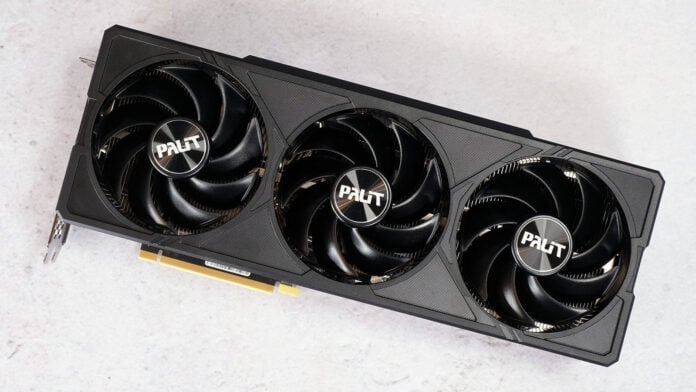Nvidia’s three-pronged RTX 40 Series refresh is off to a flying start. The first new addition, RTX 4070 Super, arrived just last week and ticks enough of the right boxes to be deemed “the most attractive QHD graphics card on the market” by yours truly. Heady praise indeed, so can Team Green continue that hot streak in week two of the Super transformation?
That responsibility is in the hands of partners taking exclusive reign of RTX 4070 Ti Super. Sounds helpful not having to compete with a lush Founders Edition, yet the truth is more nuanced than that. 4070 Ti has always served as the odd one out. Those who’ve followed the saga may recall this particular SKU began life as an $899 RTX 4080 12GB. Part of the initial 40 Series lineup, 4080 12GB was unceremoniously cancelled following an online backlash, with Nvidia openly admitting the product was “not named right.”
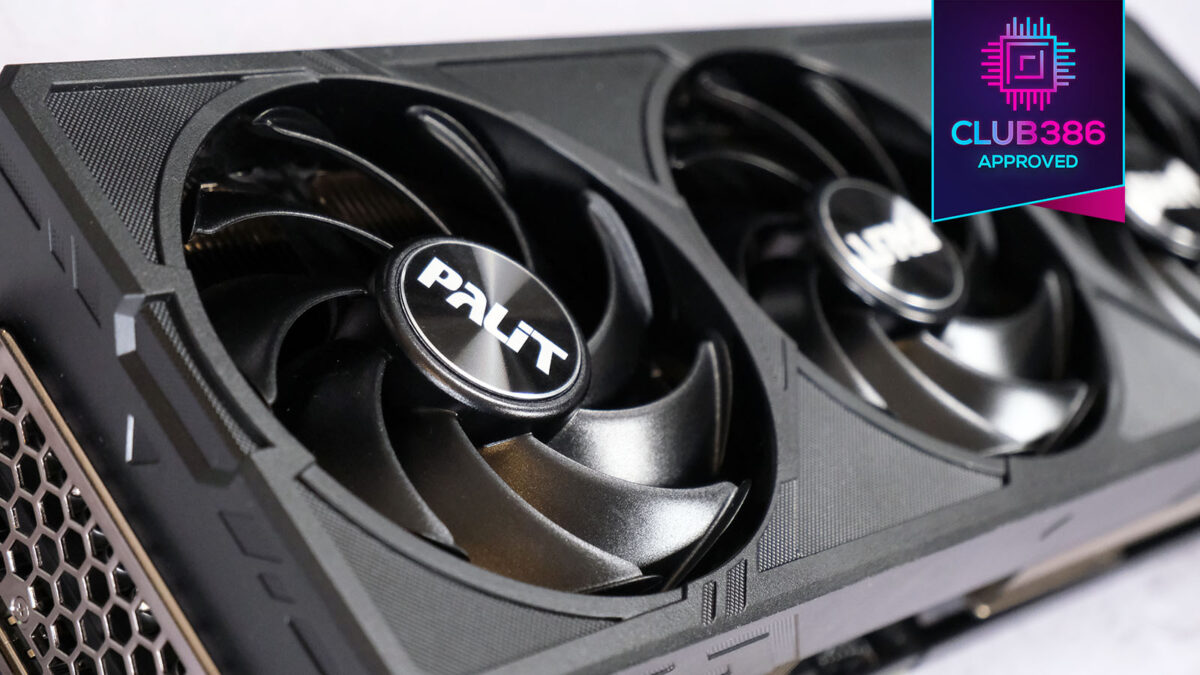
Palit GeForce RTX 4070 Ti Super JetStream
£769/ $799
Pros
- Upgraded 16GB memory
- Pulls ahead of RX 7900 XT
- Impressive DLSS 3
- Excellent efficiency
Cons
- Modest uplift over 4070 Ti
- Little OC headroom
- Large footprint
Club386 may earn an affiliate commission when you purchase products through links on our site.
How we test and review products.
A short while later 4080 12GB rides again as the partner-exclusive RTX 4070 Ti, priced a hundred bucks lower at $799. Fast forward to today and the Super refresh keeps that pricing intact while having to go to unexpected lengths in order to deliver the requisite mid-cycle performance bump. The Club386 Table of Doom™ explains.
| GeForce RTX | 4080 Super | 4080 | 4070 Ti Super | 4070 Ti | 4070 Super | 4070 |
|---|---|---|---|---|---|---|
| Launch date | Jan 2024 | Nov 2022 | Jan 2024 | Jan 2023 | Jan 2024 | Apr 2023 |
| Codename | AD103 | AD103 | AD103 | AD104 | AD104 | AD104 |
| Architecture | Ada | Ada | Ada | Ada | Ada | Ada |
| Process (nm) | 4 | 4 | 4 | 4 | 4 | 4 |
| Transistors (bn) | 45.9 | 45.9 | 45.9 | 35.8 | 35.8 | 35.8 |
| Die size (mm2) | 378.6 | 378.6 | 378.6 | 294.5 | 294.5 | 294.5 |
| SMs | 80 of 80 | 76 of 80 | 66 of 80 | 60 of 60 | 56 of 60 | 46 of 60 |
| CUDA cores | 10,240 | 9,728 | 8,448 | 7,680 | 7,168 | 5,888 |
| Boost clock (MHz) | 2,550 | 2,505 | 2,610 | 2,610 | 2,475 | 2,475 |
| Peak FP32 TFLOPS | 52 | 48.7 | 44 | 40.1 | 36 | 29.1 |
| RT cores | 80 | 76 | 66 | 60 | 56 | 46 |
| RT TFLOPS | 121 | 112.7 | 102 | 92.7 | 82.1 | 67.4 |
| Tensor cores | 320 | 304 | 264 | 240 | 224 | 184 |
| ROPs | 112 | 112 | 96 | 80 | 80 | 64 |
| Texture units | 320 | 304 | 264 | 240 | 224 | 184 |
| Memory size (GB) | 16 | 16 | 16 | 12 | 12 | 12 |
| Memory type | GDDR6X | GDDR6X | GDDR6X | GDDR6X | GDDR6X | GDDR6X |
| Memory bus (bits) | 256 | 256 | 256 | 192 | 192 | 192 |
| Memory clock (Gbps) | 23 | 22.4 | 21 | 21 | 21 | 21 |
| Bandwidth (GB/s) | 736 | 717 | 672 | 504 | 504 | 504 |
| L2 cache (MB) | 64 | 64 | 48 | 48 | 48 | 36 |
| PCIe interface | 4.0 x16 | 4.0 x16 | 4.0 x16 | 4.0 x16 | 4.0 x16 | 4.0 x16 |
| Power (watts) | 320 | 320 | 285 | 285 | 220 | 200 |
| Founders Edition | Yes | Yes | No | No | Yes | Yes |
| Launch MSRP ($) | 999 | 1,199 | 799 | 799 | 599 | 599 |
Spotted the complication? You see, RTX 4070 Ti already served as a full implementation of the AD104 die, replete with a maximum 60 SMs. No available wiggle room has dictated Nvidia’s switch to AD103, making RTX 4070 Ti Super the most affordable path to premium GeForce silicon thus far.
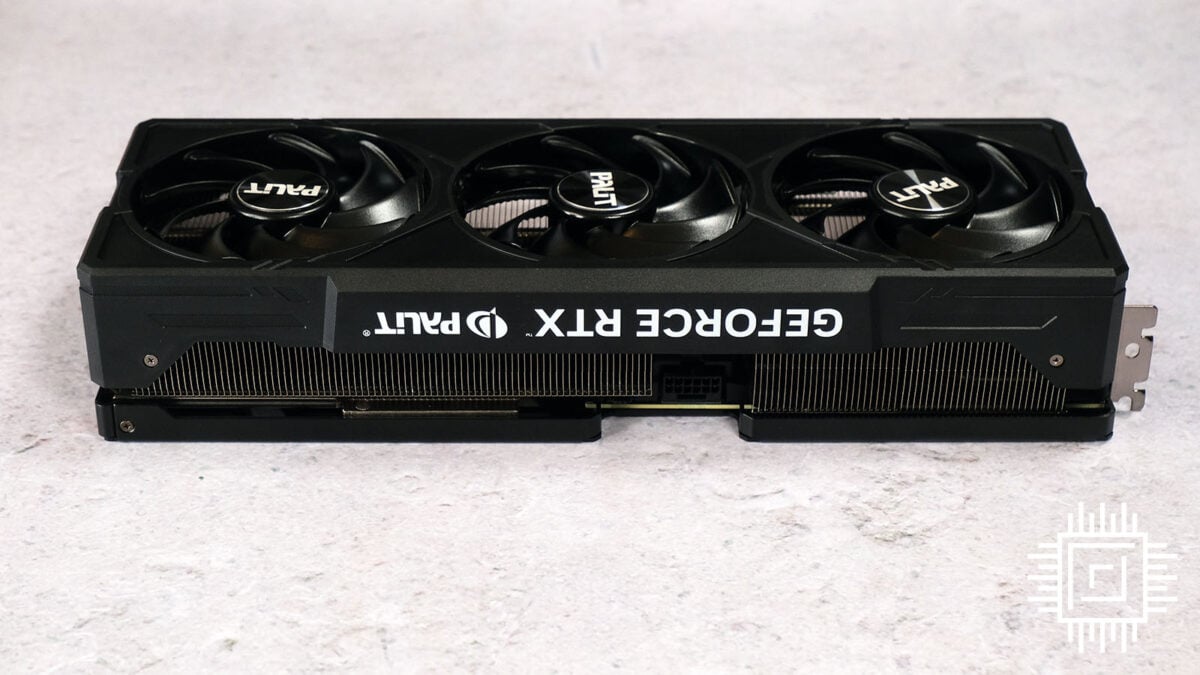
Of course, potent as the 378.6mm2 die is, distinct cost-cutting measures are in place. Operating at 82.5% of its full potential, this latest implementation ships with 66 active SMs, from a maximum 80. The runt of the litter, you might say, yet it translates to 8,448 cores, representing a welcome 10% uptick over RTX 4070 Ti regular.
On-paper frequency remains the same, yet this too is in the hands of add-in-board partners, and overclocked models are not in short supply. Better still, there are significant gains across the back end, where RTX 4070 Ti Super enjoys a 256-bit bus navigating to a large 16GB pool of GDDR6X memory. Remember who said 16GB ought to be the minimum in this day and age? Either way, we’re not complaining as bandwidth is up nearly 33 per cent and all this fits in a 285W power envelope.
Higher resolutions feel the performance advantage most keenly, though the number of ROPs isn’t quite up to RTX 4080 standards, pointing to a potential bottleneck in scenes with heavy antialiasing. Step back from the specification shenanigans and one has to wonder, why go to such lengths to sell a dearer-to-produce GPU at the same $799 (£769) price point?
It could be argued that a simple price cut on RTX 4070 Ti regular would suffice, but that’s not happening. With the release of Super variants, traditional RTX 4080 and RTX 4070 Ti are discontinued entirely, making the latter one of the shortest-lived GeForce GPUs of all time. The reason, make no mistake, is AMD Radeon RX 7900 XT. Team Red has cut the cost of its second-rung rival, and RTX 4070 Ti Super is engineered to nip that threat in the bud.
Partner Up
Over two dozen custom RTX 4070 Ti Super cards are in the works. Prices start from $799, with the more elaborate designs fetching sizeable premiums on top. Heads up: be wary of paying over the odds for this particular GPU, as the $999 RTX 4080 Super will soon hove into view, and that’s a fundamentally superior proposition.
Tried-and-trusted Palit is at hand with a choice of four models: GamingPro White OC, GamingPro OC, GamingPro and JetStream OC. The last in line meets Nvidia’s $799 MSRP, automatically making it our pick of the bunch.
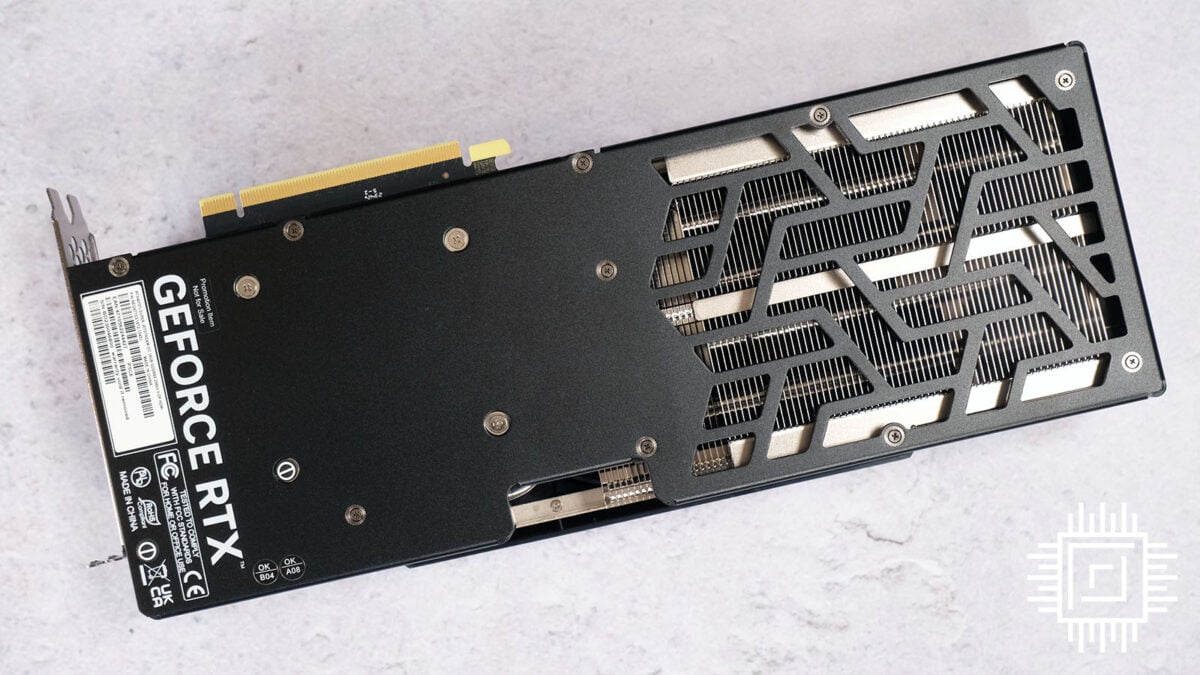
Even as Palit’s most affordable solution, it’s clear you’re getting a lot of card for the money. This beast measures 329mm x 131mm x 63.5mm and tips the scales at 1.45kg. JetStream is officially a ‘3.1 slot’ form factor, which in marketing terms translates to “your PCIe slots belong to me.”
Plenty of bulk, but as expected for a base model, not a great deal of extra features. Don’t count on a dual BIOS, there’s no RGB to speak of – or any illumination at all, for that matter – and the plastic fan shroud has a little more flex than you might expect on dearer models. Nevertheless, it’s nice to see a full-length backplate included as standard, and the airflow cutouts add a certain amount of visual interest.
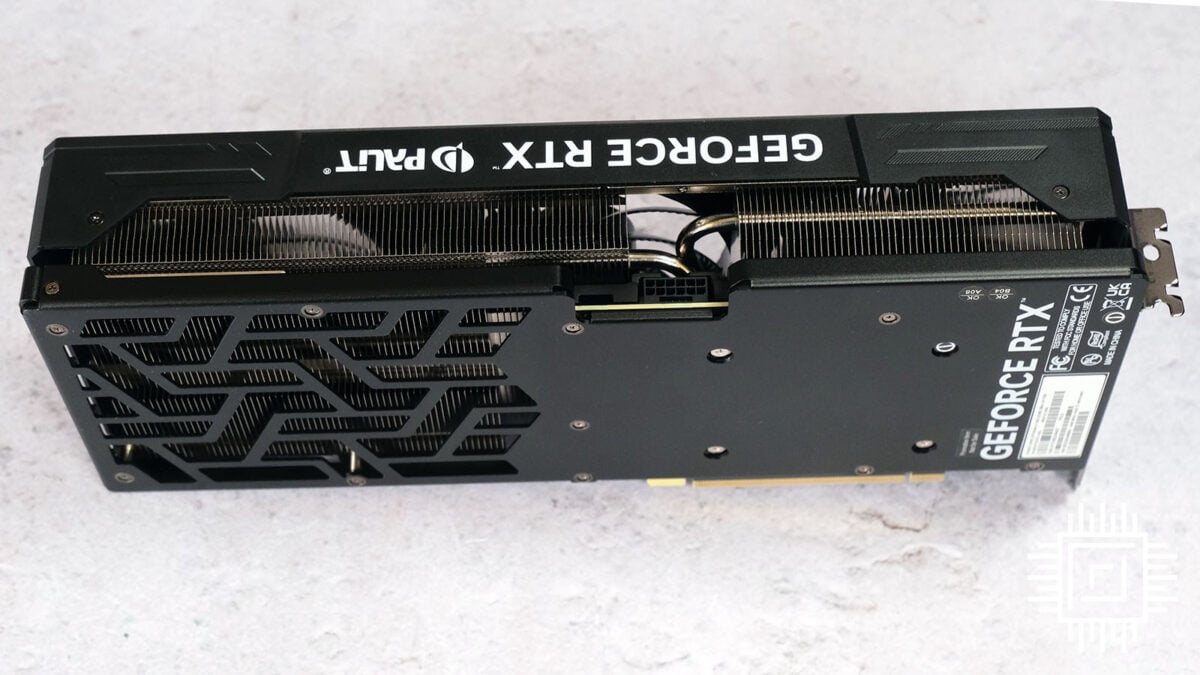
More importantly, cooling is plenty sufficient. A trio of ‘Gale Hunter’ fans sit atop a huge heatsink array that traverses an ultra-wide copper base geared to wick heat away from the GPU. It barely gets hot under load, and all three fans carry 0dB tech, whereby they stop spinning entirely at low load to eliminate fan noise. Always nice to have, though the ramp-up from off to on could be a wee bit smoother.
Given the size of the cooling assembly, it is interesting to note the underlying PCB, reinforced with another metal plate to prevent bending, is roughly half the card’s total length. As a result, the single 12VHPWR connector is positioned somewhat awkwardly; we’d prefer it nearer the back than the front. Palit includes a dual-eight-pin splitter in the box for backward compatibility, but there’s no GPU support bracket. You may wish to source your own to avoid the dreaded sag.
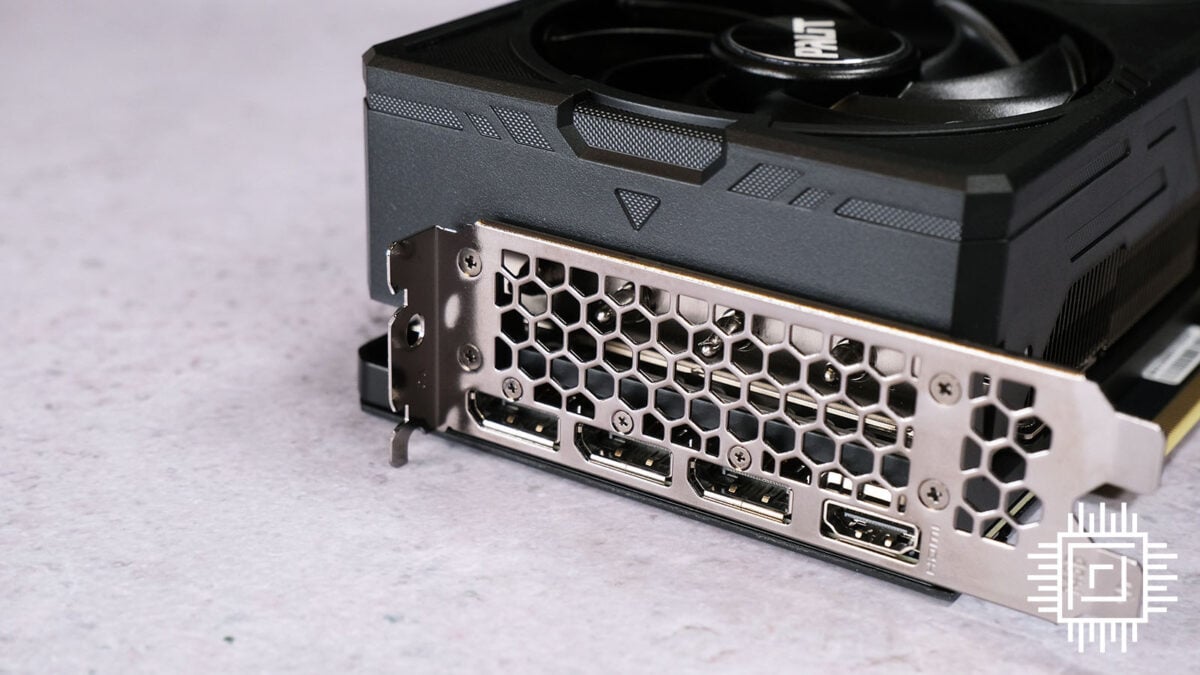
There are no unwanted surprises in the output department, where the JetStream card presents the usual trio of DisplayPort 1.4 and a single HDMI. Sufficient for native 4K120 or 4K144, respectively, though you will need to add Display Stream Compression (DSC) to hit the dizzy heights of 4K at 240Hz.
Finally, there is a minor factory overclock, with Palit choosing to elevate boost clock from 2,610MHz to 2,640MHz. Memory remains untouched at an effective 21Gbps.
Enough preamble, the big question is whether or not GeForce RTX 4070 Ti Super can disrupt Radeon RX 7900 XT. Only one way to find out, let’s fire up the benchmarks.
Benchmarking
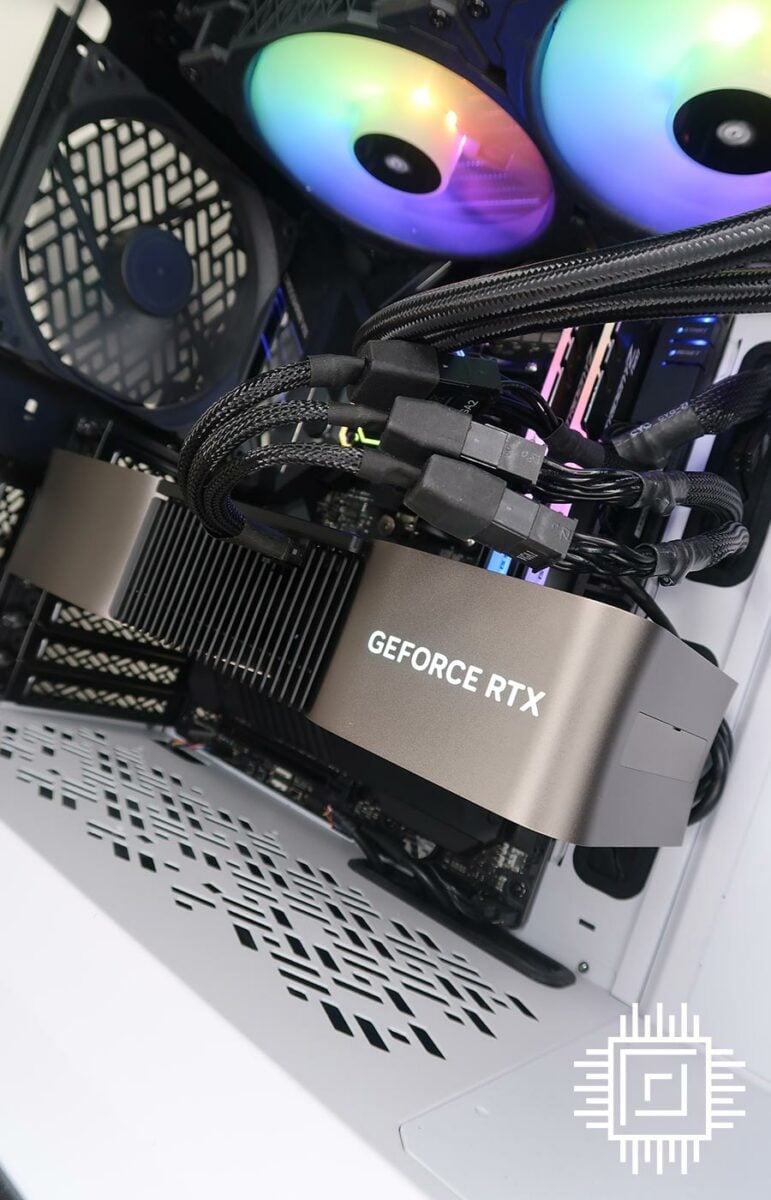
Our 5950X Test PCs
Club386 carefully chooses each component in a test bench to best suit the review at hand. When you view our benchmarks, you’re not just getting an opinion, but the results of rigorous testing carried out using hardware we trust.
Shop Club386 test platform components:
CPU: AMD Ryzen 9 5950X
Motherboard: Asus ROG X570 Crosshair VIII Formula
Cooler: Corsair Hydro Series H150i Pro RGB
Memory: 32GB G.Skill Trident Z Neo DDR4
Storage: 2TB Corsair MP600 SSD
PSU: be quiet! Straight Power 11 Platinum 1300W
Chassis: Fractal Design Define 7 Clear TG
Our trusty test platforms are nearing retirement, yet it is it testament to the Ryzen 9 5950X build that our twin AM4 rigs continue to function reliably irrespective of the numerous graphics cards thrown at it.
3DMark





3DMark Time Spy reveals RTX 4070 Ti Super to be, on average, 5% quicker than RTX 4070 Ti regular. A small bump has the latest GeForce snapping at the RX 7900 XT’s heels but isn’t quite enough to overtake the Radeon in synthetic tests.
The GeForce remains clearly superior in raytracing, where RTX 4070 Ti stretches out a whopping 65% performance advantage.
Gaming


Focussing on in-game performance, Assassin’s Creed Valhalla reveals very little separates the GeForce and Radeon competitors.
Does 16GB of RAM make an impact at even higher resolutions? You betcha. While RTX 4070 Ti returns 78fps at 4K in this title, RTX 4070 Ti Super manages 91fps. As expected, given the back-end upgrades, performance scales neatly with resolution.


Palit’s Super card remained locked at 2,745MHz while gaming. Expect this to be on the conservative side for an RTX 4070 Ti Super.
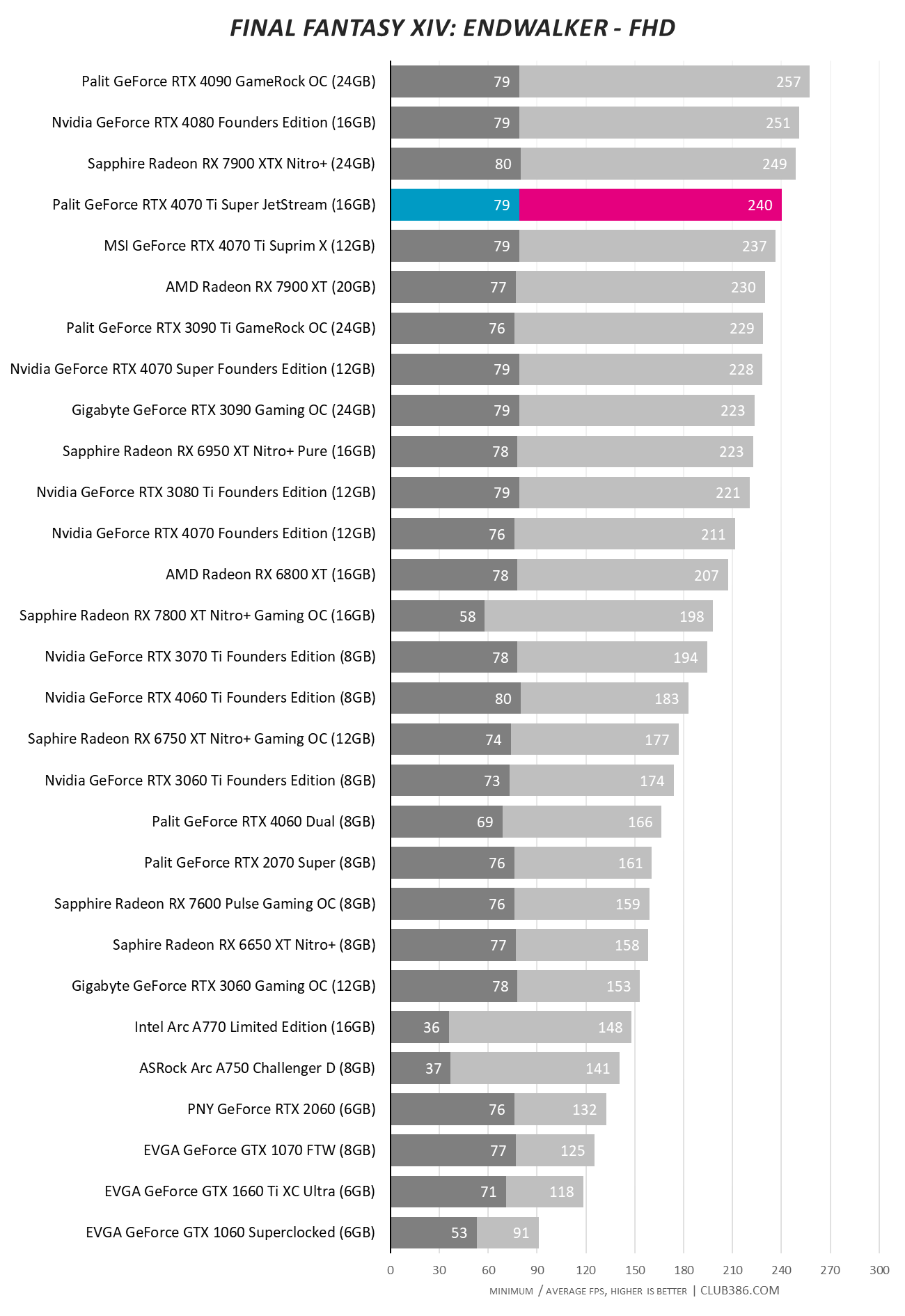
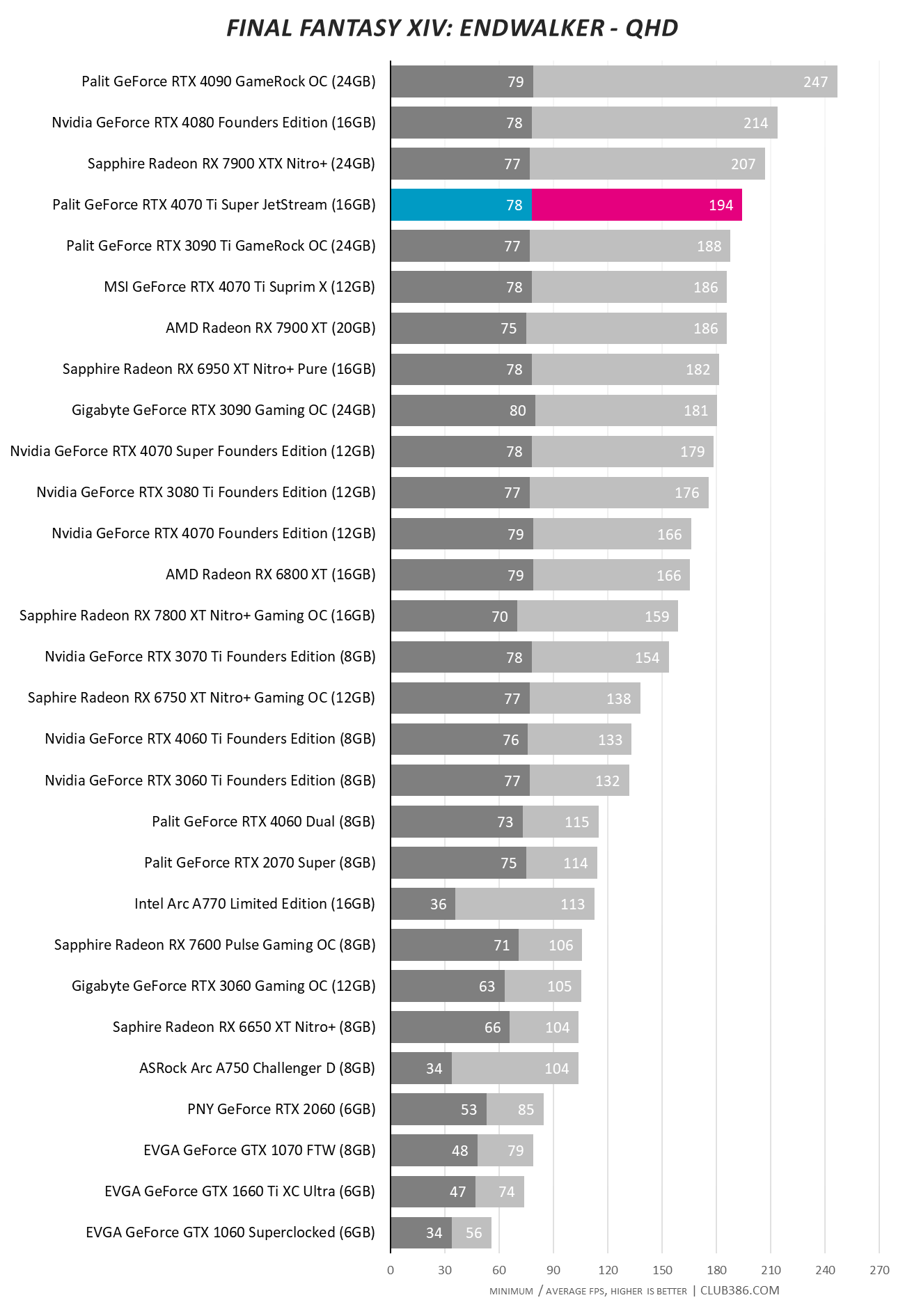
An incremental upgrade over RTX 4070 Ti, Palit’s Super helps stretch out the lead over Radeon RX 7900 XT. Exactly what Dr Nvidia ordered.
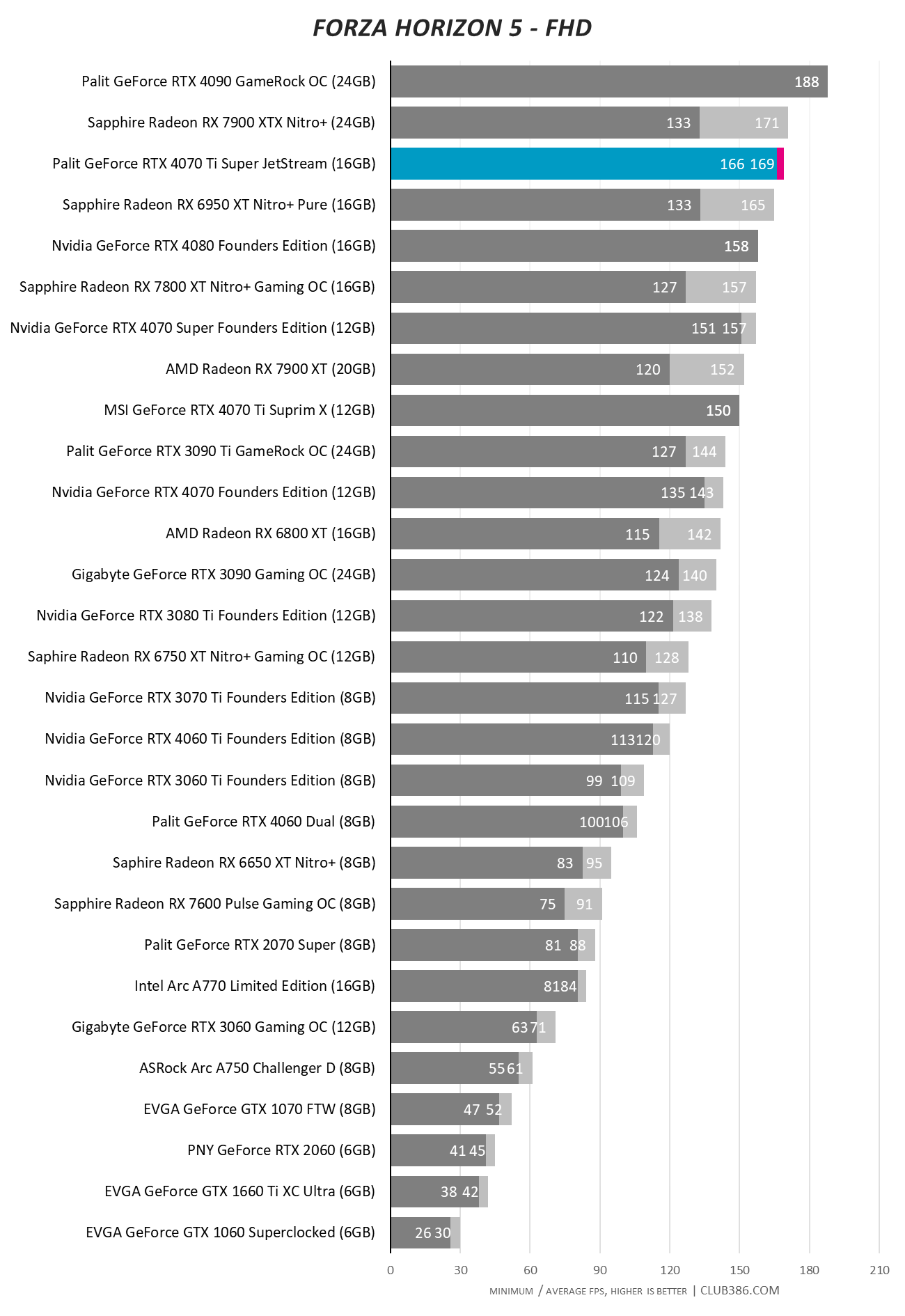
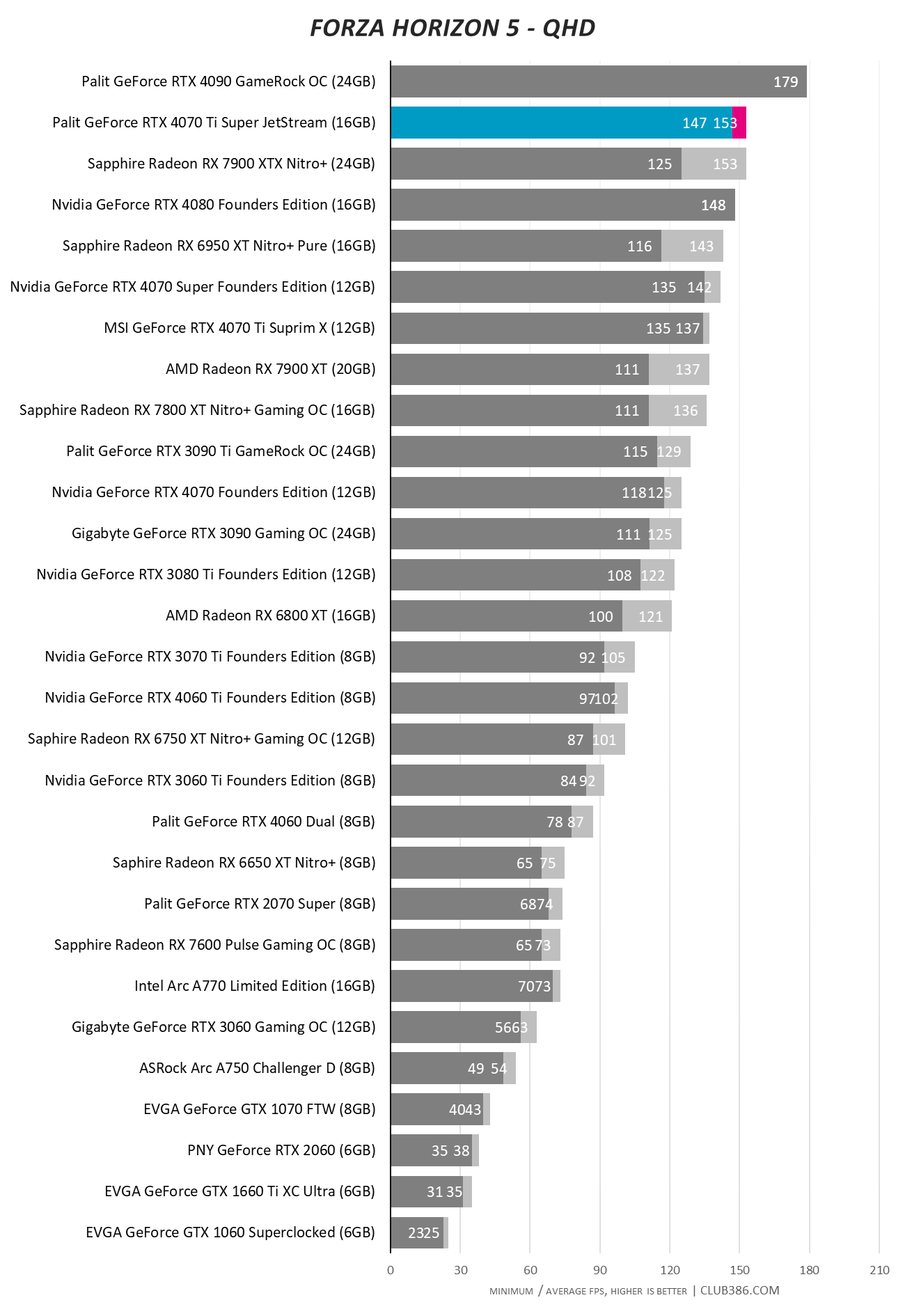
RTX 4070 Ti Super shouldn’t be beating an RTX 4080, but we can put this unexpected result down to the very latest press driver used for review.
The Palit card can be deemed a sideward step for the most part. It makes most sense when transitioning from older hardware. Upgrading from RTX 3070 Ti nets a 46% uptick in average frames per second. Migrate from RTX 2070 Super and framerates more than double.
DLSS 3
It wouldn’t be an RTX 40 Series review without mentioning DLSS, which in fairness is growing all the more impressive with each iteration. The promise of both upscaling and frame generation is genuine, and when implemented correctly leads to huge performance gains with barely any discernible impact on visual fidelity. Cyberpunk 2077 is a fine example of a developer getting it right.
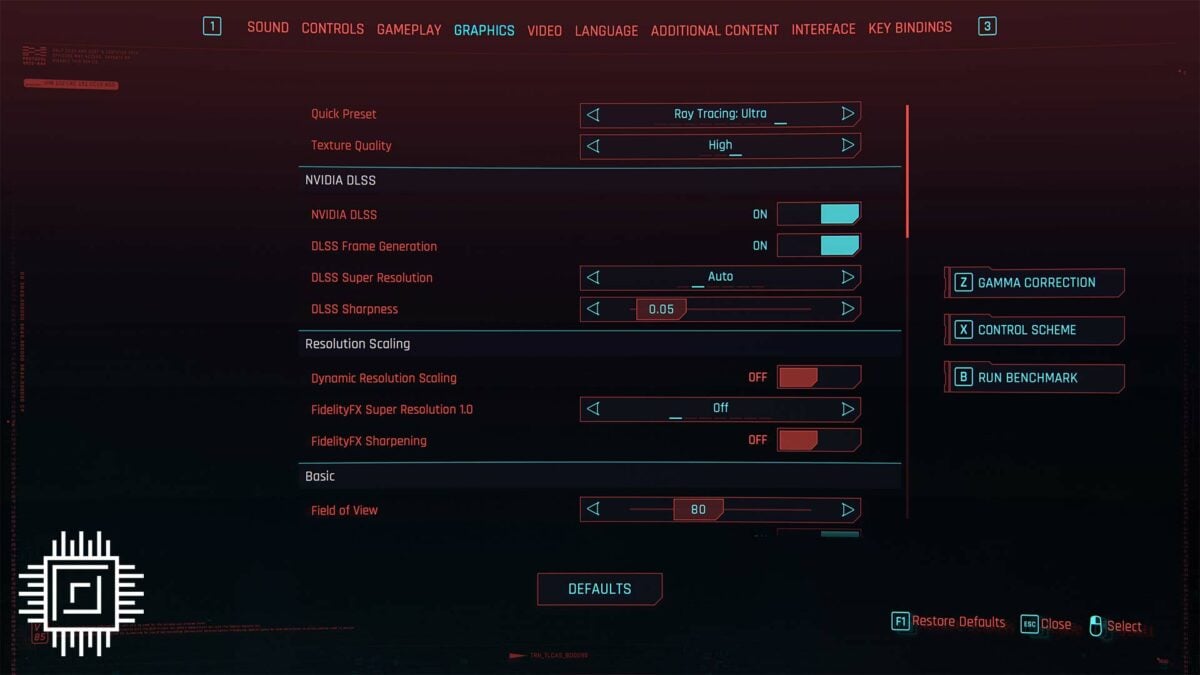
Granular options provide plenty of choice. Remember, Super Resolution provides a choice of upscaling settings; Performance works its magic on a 1920×1080 render, Balanced works at 2227×1253, and Quality upscales from 2560×1440. On top of that, Frame Generation can be enabled with the flick of a switch to insert a synthesised frame between two rendered. The end result, in plain English, is a framerate boost like no other.
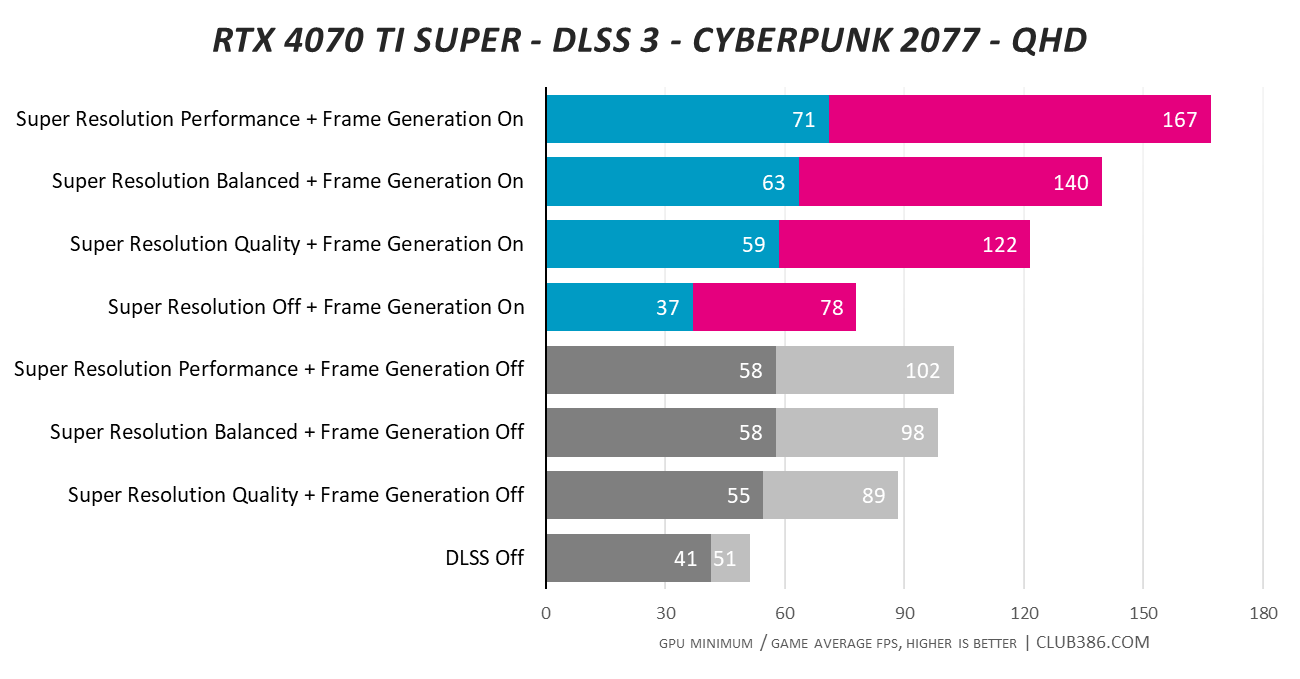
While rivals are scrambling to catch up with upscaling and frame generation technologies of their own, it’s clear Nvidia remains the frontrunner. The performance uplift on RTX 4070 Ti in ultra-demanding titles is nothing short of astonishing.
Efficiency
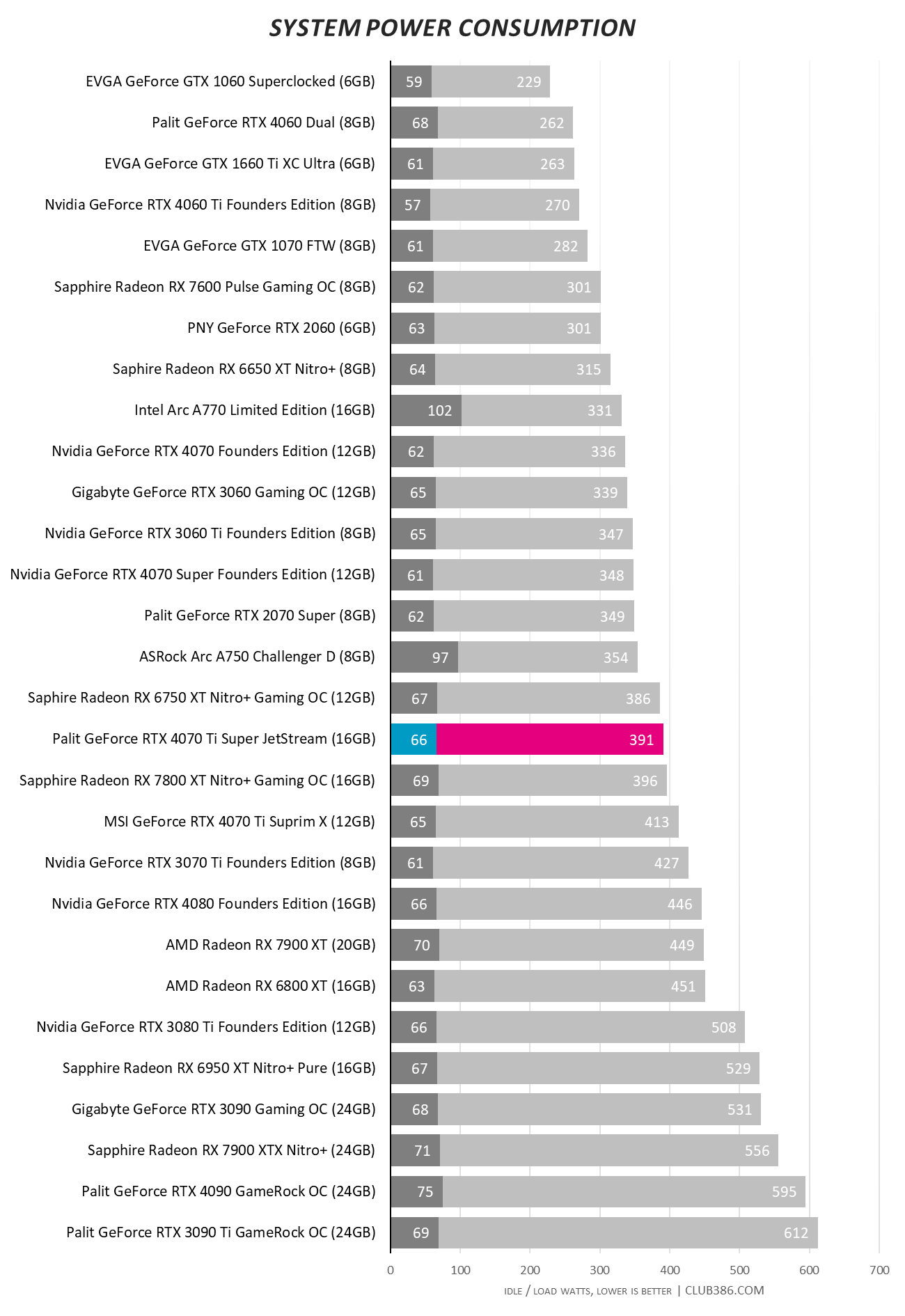
Palit’s conservative clock speeds bode well for electricity usage. The Super card actually draws less power than a heavily overclocked RTX 4070 Ti regular. Mark this one down as another win over RX 7900 XT, too.
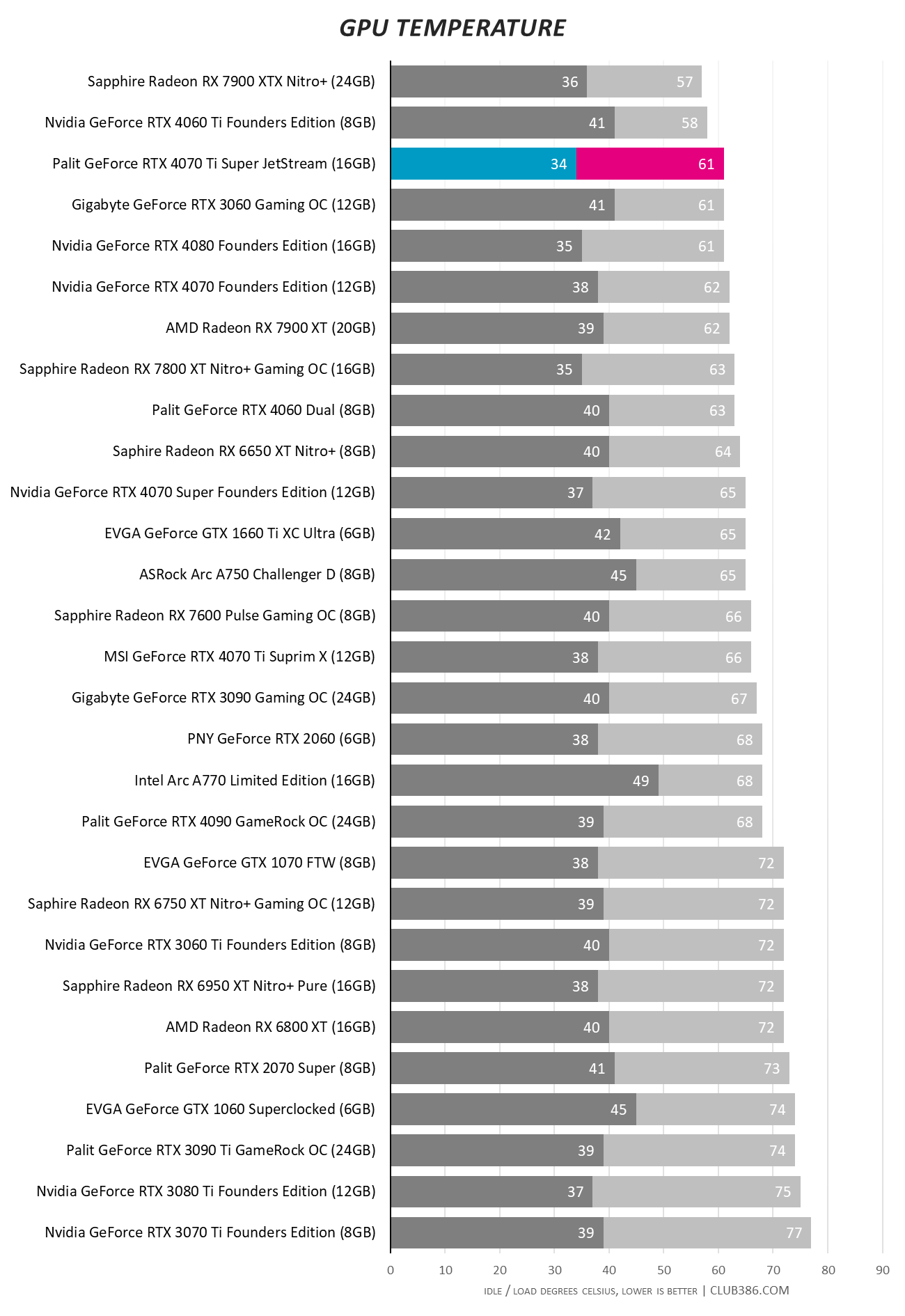
Conservative clocks, low power consumption and a hulking triple-fan cooler can mean only one thing: low temps. RTX 4070 Ti Super JetStream barely breaks a sweat here.
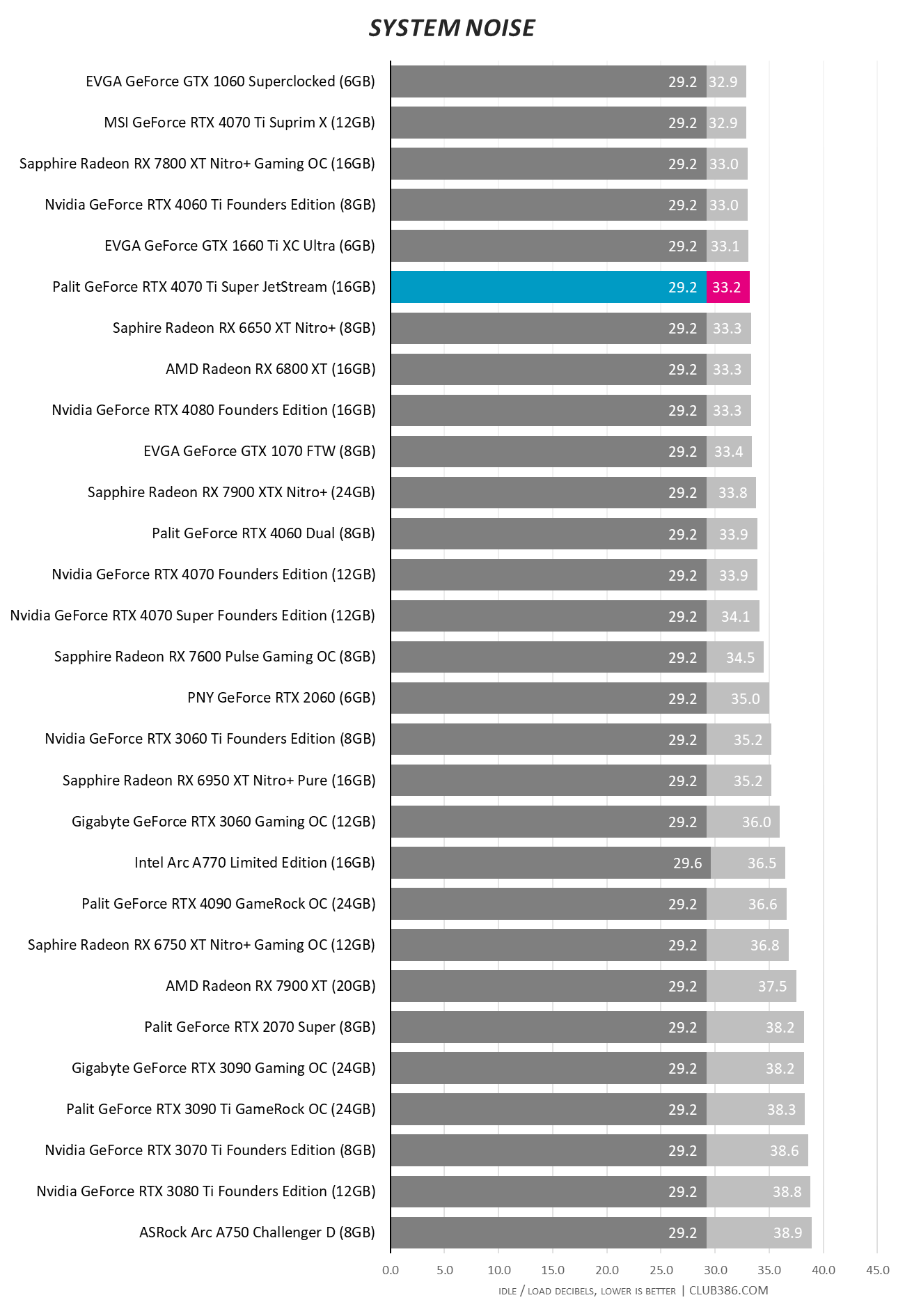
Though fan ramp-up could be smoother, this is ultimately a card that never gets overly hot or bothered.
Relative Performance
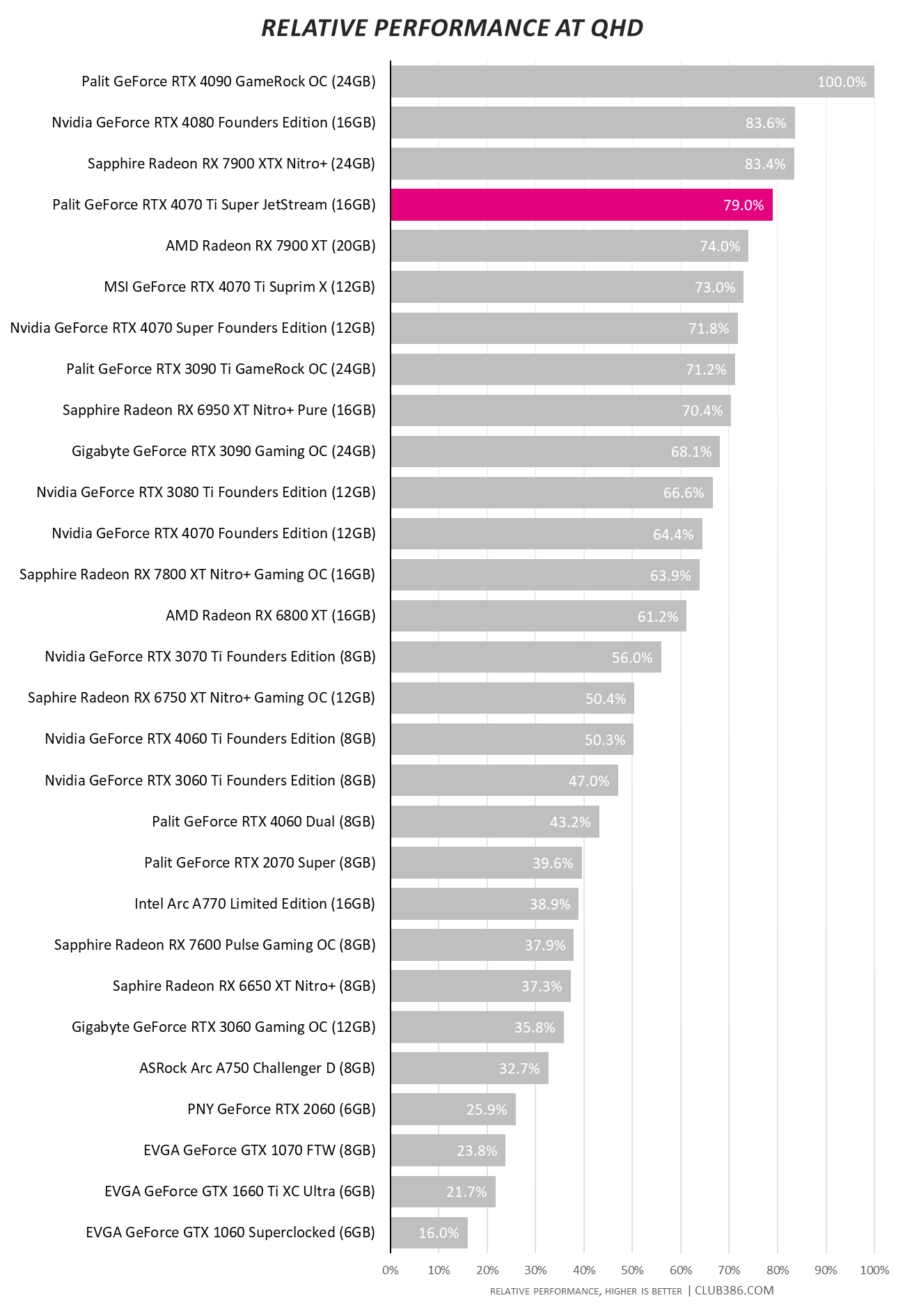
Evaluating relative performance across a variety of benchmarked games reveals RTX 4070 Ti Super is successful in getting ahead of Radeon RX 7900 XT.
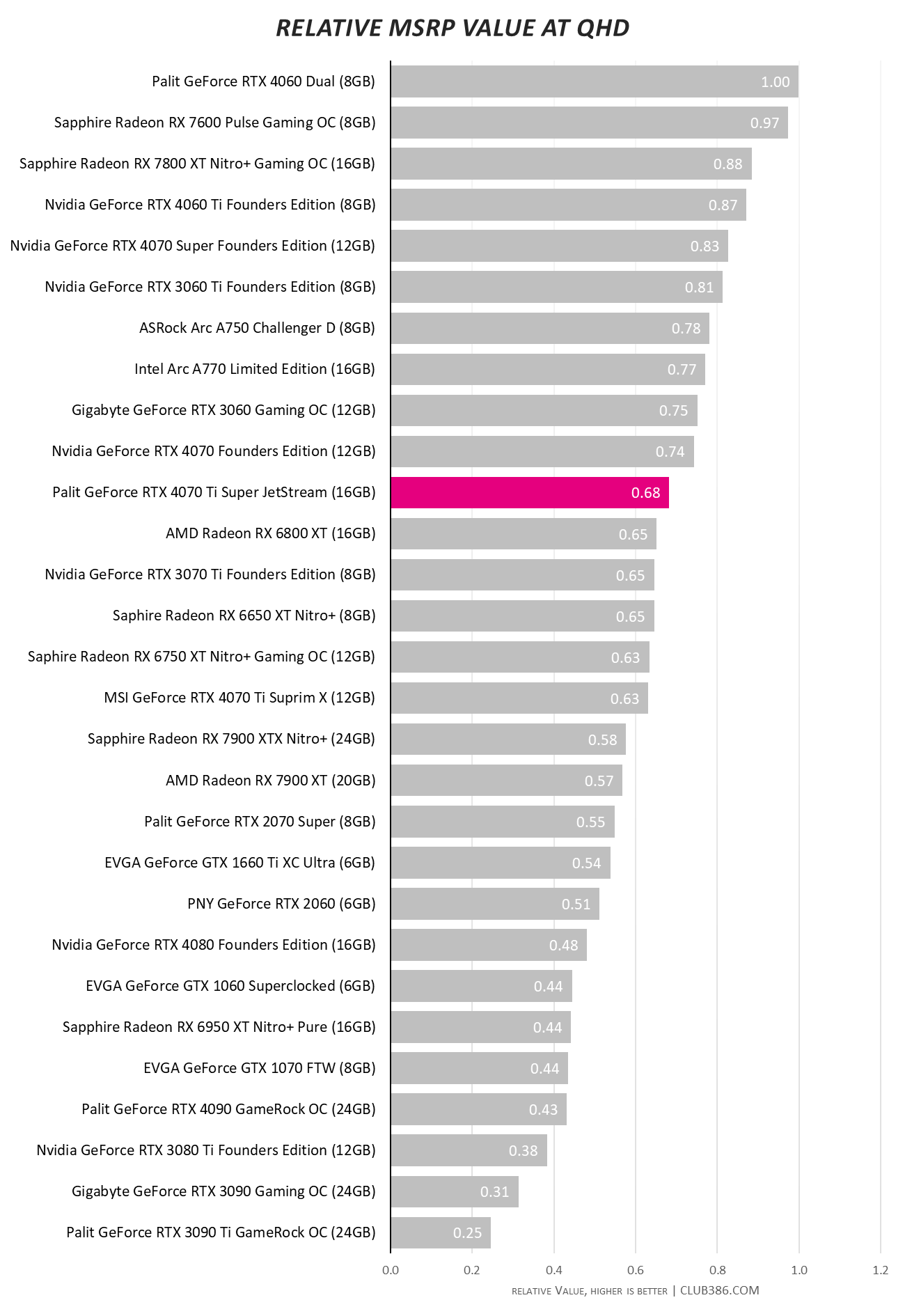
The value proposition of Nvidia’s $799 tier is typically mid-pack. That hasn’t changed, and it’s worth noting the above graph depicts each GPU’s official MSRP. At the time of writing, RX 7900 XT is available for $710. That price tag elevates the relative value rating from 0.57 to a much more competitive 0.72.
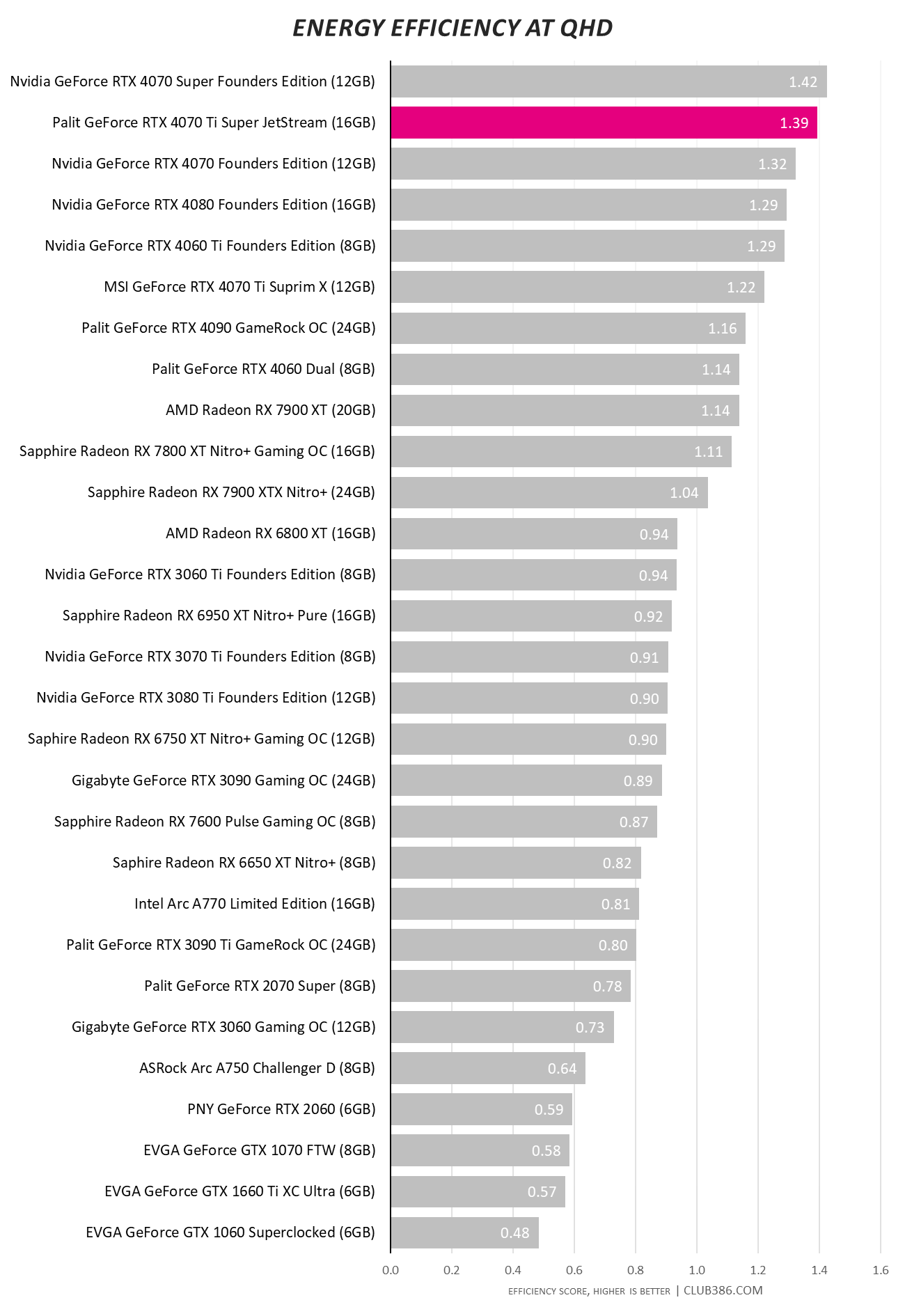
Taking the axe to pricing allows competitors to compete with Nvidia on a price-to-performance ratio. There is no contest on an efficiency basis. Both Super cards lead the way.
Overclocking
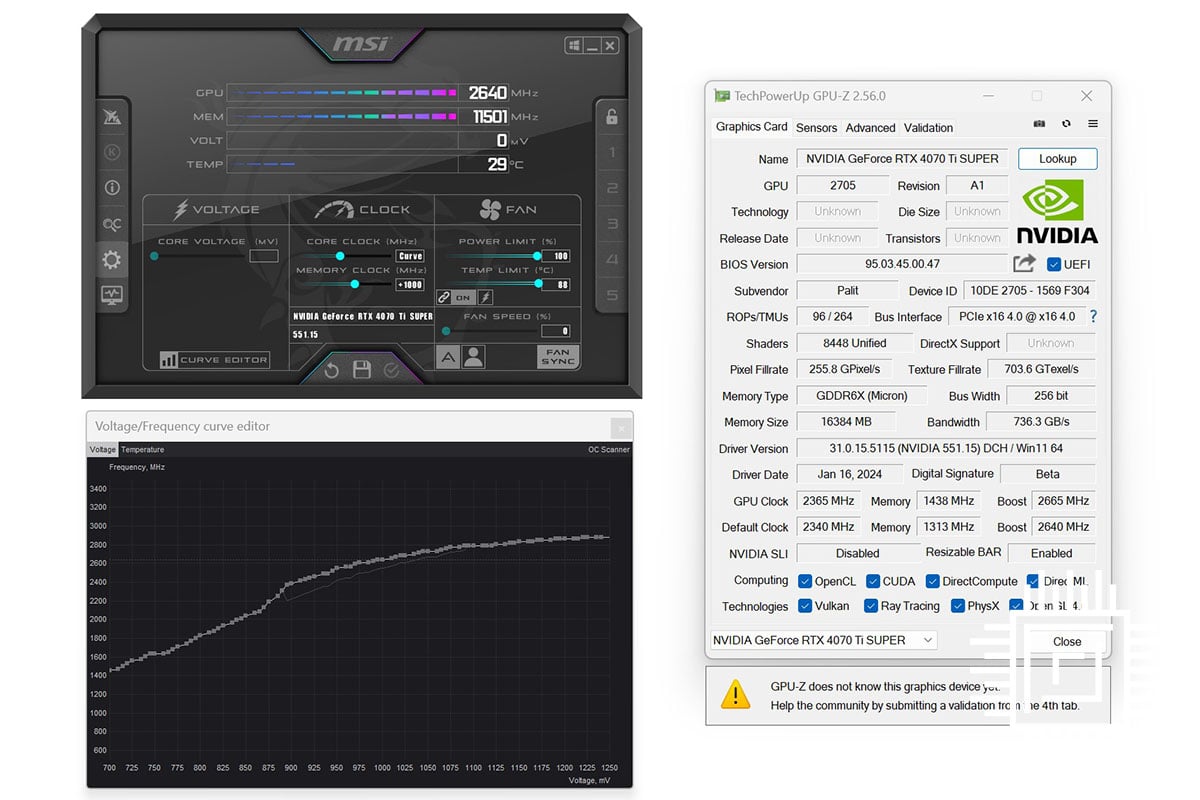
Word of caution: if overclocking is a priority, Palit’s JetStream may not be the card for you. Board power limit is BIOS-restricted to 100%, making it tricky to explore additional headroom using conventional means.
Frequency gains using automated scanners are middling, though memory is easily uplifted to 23Gbps.
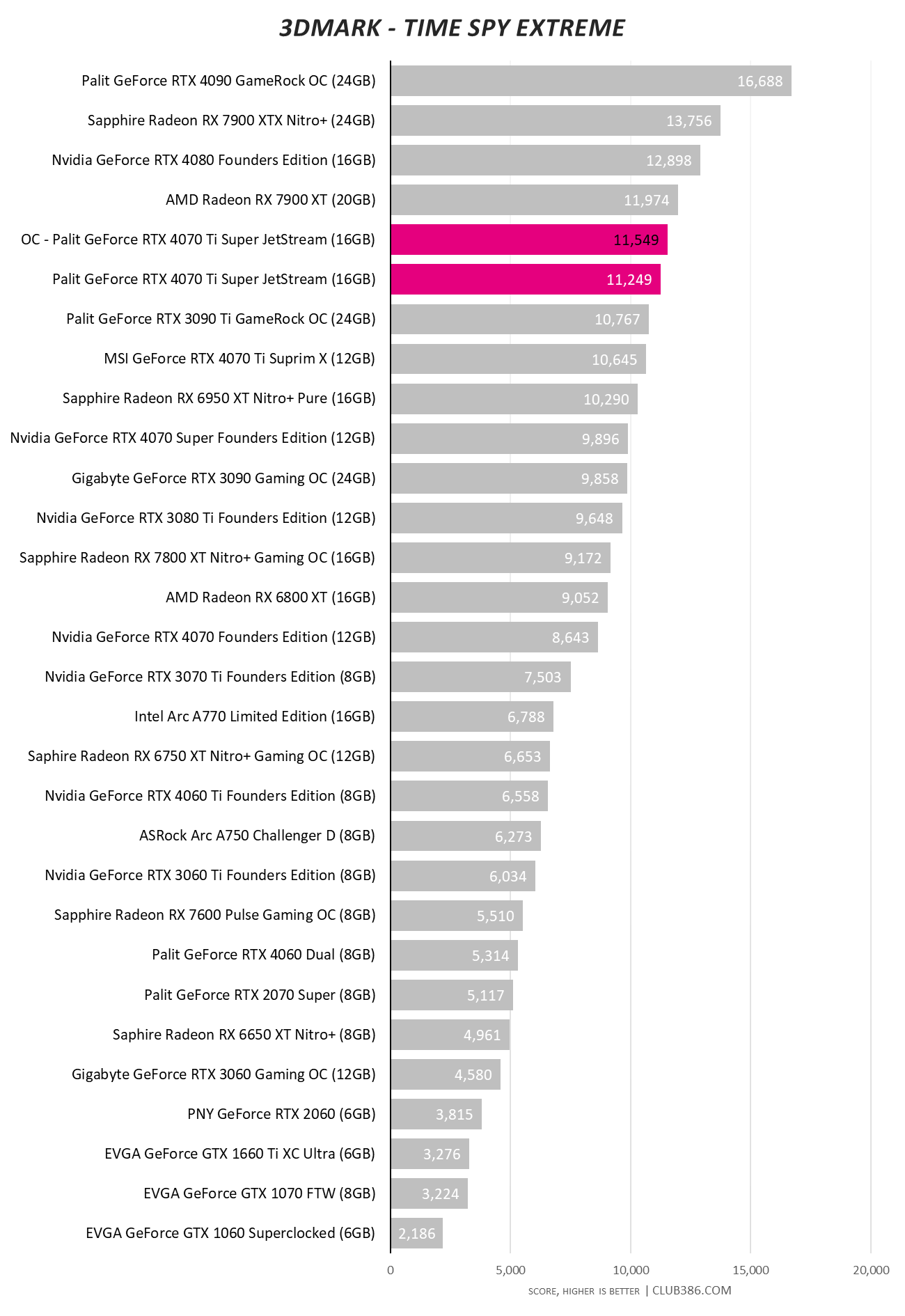
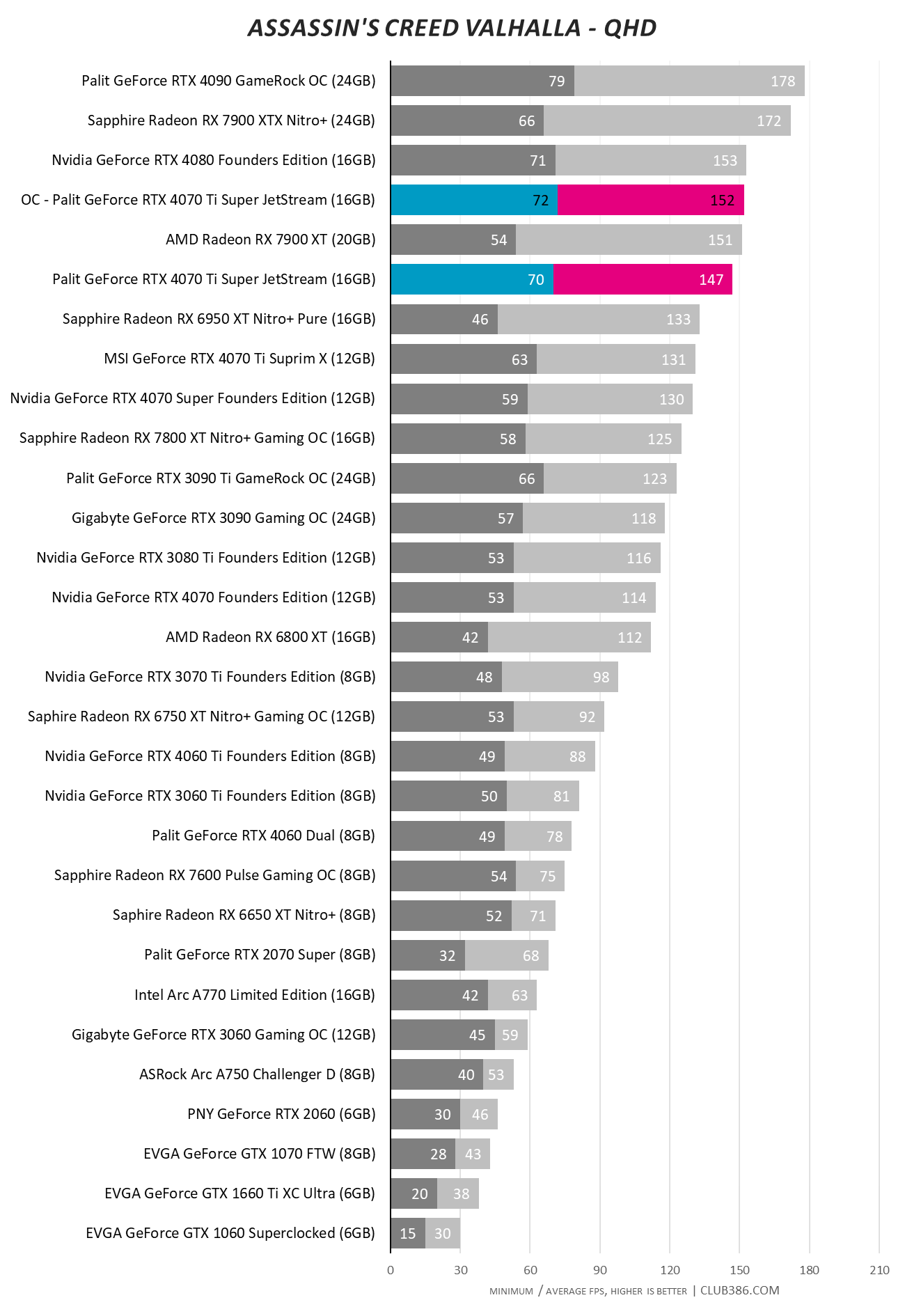
It is possible to eke out a few extra frames here or there. Nevertheless, this isn’t an RTX 4070 Ti Super intended to push well beyond factory specifications.
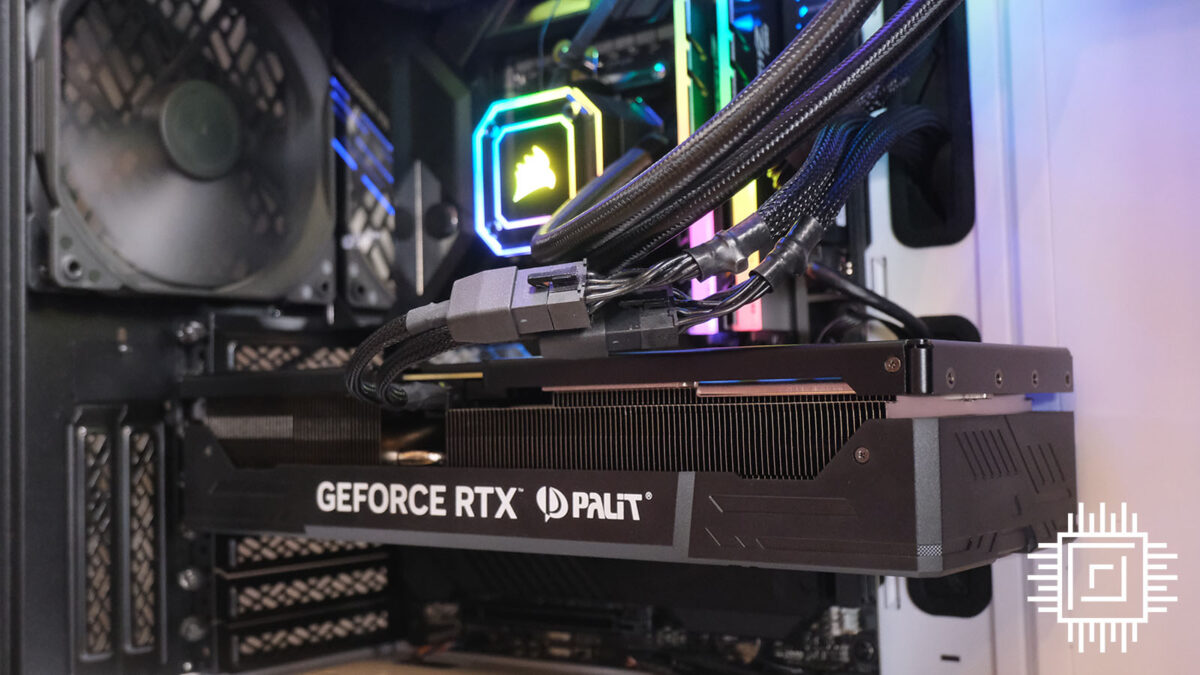
Conclusion
Nvidia is bolstering the appeal of its $799 proposition with a Super makeover imbued with a modest uptick in processor cores and a beefed-up backend sporting 16GB of memory via a 256-bit bus.
The benefit of such niceties is felt at higher resolutions, where more VRAM proves its worth. Add best-in-class efficiency, raytracing and frame generation to the equation, and you have a GPU expertly positioned to put the hurt on Radeon RX 7900 XT.
AMD’s riposte is likely to incur further prices cuts, which is good news for consumers. GeForce RTX 4070 Ti Super should be the graphics card to go for at $799 / £769, but that victory is less clear cut as rival Radeon RX 7900 XT edges closer to the £700 mark. Given value in this segment remains hard to find, here’s hoping prices continue to head in the right direction.
Verdict: well suited to high-res gameplay, RTX 4070 Ti Super puts RX 7900 XT in a quandary.

